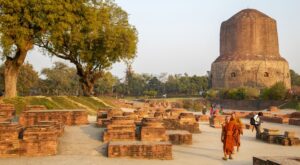Context

Ahead of the UNESCO team’s visit to Sarnath, the Archaeological Survey of India (ASI) will install a new corrected plaque to acknowledge the role of Raja Bagat Singh in preserving the site, instead of crediting the British.
Sarnath, located near Varanasi, is one of the most important Buddhist heritage sites, where Gautama Buddha delivered his first sermon in 528 BCE. It is also the location of the Lion Capital of Ashoka, which today serves as the National Emblem of India.
Historical Significance of Sarnath
- Buddha’s First Sermon (Dhammachakra Pravartana)
- After attaining enlightenment at Bodh Gaya, Buddha came to Sarnath to teach the Four Noble Truths and the Eightfold Path.
- This event marked the foundation of Buddhism’s spiritual and philosophical journey.
- Ashokan Era Development
- Emperor Ashoka (268-232 BCE) constructed the Dhamek Stupa, monastic complexes, and other structures to promote Buddhism.
- The Lion Capital, originally atop a pillar at Sarnath, symbolized the spread of Dharma and later became India’s National Emblem in 1950.
- Later Patronage
- Kushana Dynasty (1st–4th Century CE) and Gupta Dynasty (3rd–6th Century CE) further expanded Sarnath, refurbishing monasteries and stupas.
Destruction and Decline
- Sarnath faced widespread destruction in the 12th century, linked to invasions:
- Archaeological evidence indicates that monasteries were looted and burned.
- Buddhist monks and scholars were killed or dispersed, leading to a sharp decline in Buddhism in northern India.
- Some accounts describe statues and sacred relics being thrown into the Ganges during this period.
- The site lay in ruins for centuries, surviving only in scattered remnants.
Rediscovery During Colonial Period
- Early British Interest
- British archaeologists initially excavated the site due to its proximity to Varanasi, a major colonial hub.
- Early discoveries included inscriptions, statues, and relics, sparking wider interest.
- Alexander Cunningham’s Work (1830s-40s)
- Cunningham, the first Director-General of the ASI, led systematic excavations.
- By 1836, he conclusively identified Sarnath as the location of Buddha’s first sermon.
- Later, German archaeologist Friedrich Oertel (1904-05) carried out extensive documentation of Sarnath’s architecture and inscriptions.
- Misattribution in Colonial Records
- British records often ignored Indian efforts to protect Sarnath.
- Contributions of local rulers like Raja Bagat Singh were overlooked.
Modern Developments
- Plaque Correction by ASI:
- The ASI will now credit Raja Bagat Singh for his role in safeguarding Sarnath during the late 18th century.
- Earlier plaques falsely suggested that the British discovered and protected the site.
- UNESCO World Heritage Nomination:
- Sarnath is being considered for inclusion in the UNESCO World Heritage List (2025-2026 cycle).
- This would officially recognize Sarnath’s global historical and spiritual significance.
Key Structures at Sarnath
- Dhamek Stupa – Commemorates Buddha’s first sermon.
- Chaukhandi Stupa – Marks the site where Buddha met his first disciples.
- Mulagandha Kuti Vihara – Modern temple with relics of Buddha.
- Ashokan Pillar (Lion Capital) – Symbol of India’s state authority and heritage.




